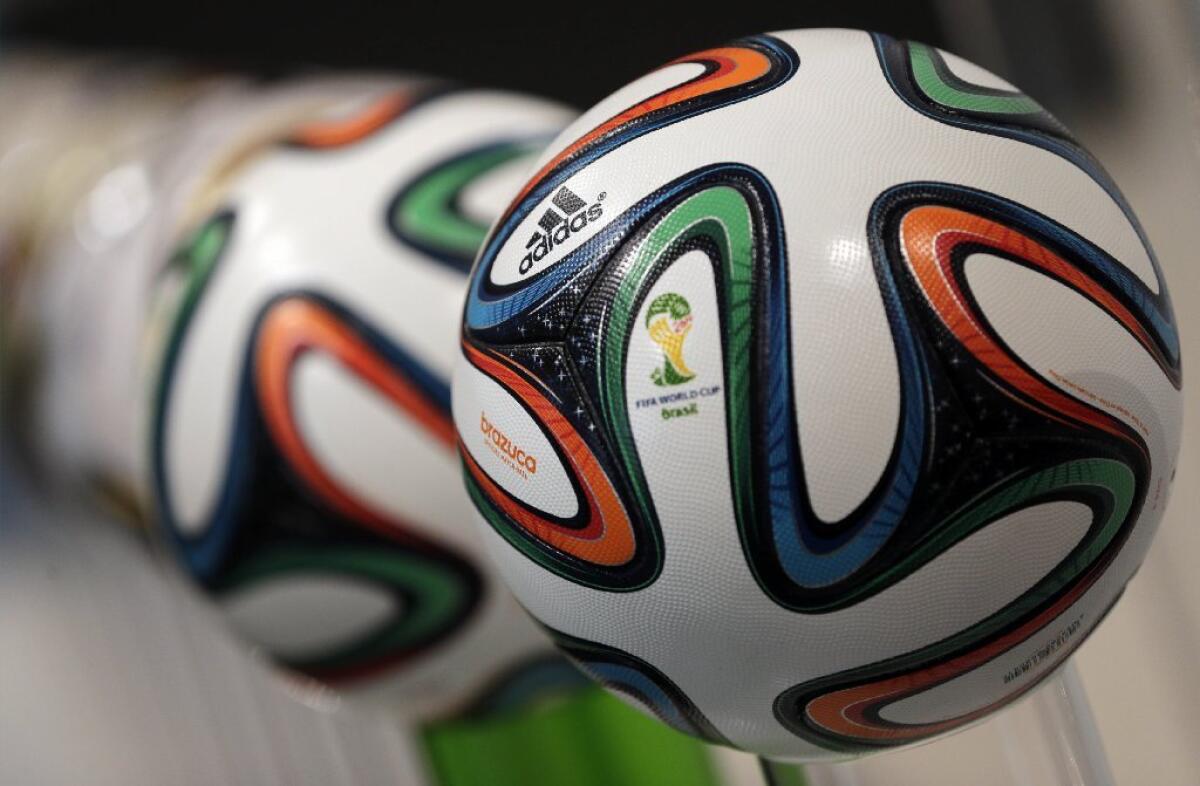At least the Brazuca soccer ball is ready for the 2014 FIFA World Cup

- Share via
Three of the 12 soccer stadiums where Brazil will host the FIFA World Cup are still under construction. Only 1 in 3 Brazilians thinks the monthlong tournament will be good for their country’s economy. But with the kickoff only days away, at least one crucial element appears to be in good shape: the soccer ball.
So say a pair of researchers from the Institute of Health and Sports Science at the University of Tsukuba in Japan.
In a study published in the journal Scientific Reports, Sungchan Hong and Takeshi Asai analyzed the aerodynamic properties of the Brazuca, the official ball of the 2014 World Cup. After subjecting it to tests in a wind tunnel and having a robot kick it into a net 40 times, the researchers declared that the ball follows a reliable trajectory no matter which side meets a foot.
Picture a soccer ball and the image that comes to mind is probably a sphere made up of 32 smooth panels – 12 black pentagons and 20 white hexagons. But this conventional ball is oh so passe.
In the last decade, Adidas has come up with no fewer than four designs for international soccer tournaments. There was the Teamgeist 2, a 14-panel ball introduced for the 2008 Euro Cup. That was followed by the Jabulani, which has eight textured panels and debuted at the 2010 FIFA World Cup in South Africa. Players in the 2013 FIFA Confederations Cup in Brazil used the Cafusa, which has 32 panels arranged in overlapping circles.
For this year’s World Cup, Adidas created the Brazuca. The ball has six textured panels shaped like stylized Xs.
These differences aren’t merely cosmetic. The Jabulani, for instance, was criticized by players and coaches for changing directions mid-flight.
Hong and Asai decided to put these five balls through a battery of tests to assess their performance. Though the pair weren’t the first researchers to bring scientific rigor to the job, they say their analysis is unique because it correlates the results of wind tunnel tests with actual trajectories through the air.
The wind tunnel experiments revealed that the Brazuca was tops when it came to the stability of the drag forces (or air resistance) acting on the ball. All of the balls were tested in two different orientations, and the results for the Jabulani and the Cafusa were quite different depending on which side of the ball was facing into the wind. But the plots for the Brazuca were nearly identical in both conditions.
Another set of wind tunnel tests measured the side and lift forces of the balls as their (simulated) velocity increased from 20 to 30 meters per second. (In reality, the balls remained stationary and the wind blew faster.) Once again, the Brazuca performed well (though the Teamgeist 2 was better) and the Jabulani performed poorly.
In the final set of tests, each soccer ball was struck 40 times (20 times in each of two orientations) by an “impact-type kick robot” that delivered the ball to a goal net 25 meters away. The Brazuca and the conventional ball were most likely to wind up in the same part of the net after each kick. The flights of the other balls changed quite a bit depending on which side was facing the kicking robot.
If all this analysis seems like overkill, Hong and Asai beg to differ.
“The scientific clarification of the effects of different surface shapes … of soccer balls would facilitate the learning of more efficient shooting techniques, contribute to enhanced player performance and improve physical education teaching methods in schools,” they wrote.
Asai is something of a soccer nut. Last year, he and his colleagues published a paper detailing how a goalie uses his legs to propel himself toward a ball kicked by the opposing team. He also serves as general manager of his university’s soccer club.
Asai and Hong have teamed up to study the best way to execute a “knuckleball” shot, which Cristiano Ronaldo uses to send free kicks to the back of the opposing team’s net. With the help of high-speed cameras, the researchers determined that a small angle of attack is key to success. They have also investigated the biomechanics of the hips, legs and feet that make the knuckleball possible.




